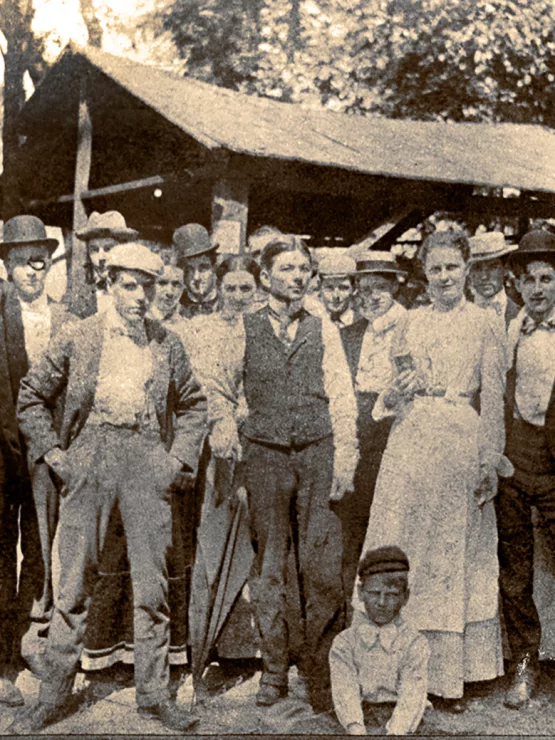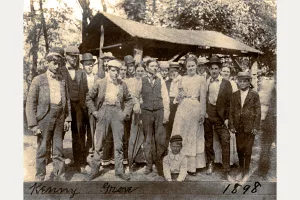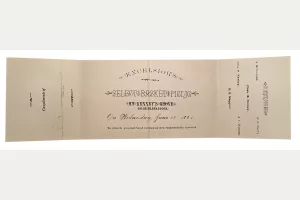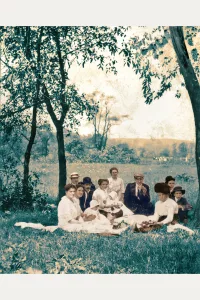In the late 1800s, the breezy hilltop southeast of Pittsburgh that is now home to Kennywood Park drew people from across the region for picnics, dancing, and other, less-wholesome entertainment. Kenny’s Grove wasn’t the only picnic ground in the region, and not the only one to grow into a trolley park, but its struggle to evolve and survive is unique for the past 125 years.
As steel mills started lining Western Pennsylvania’s three rivers after the Civil War, picnic groves began popping up on hilltops as places to escape the smoke and soot. Kenny’s Grove was located between the bustling mill towns of Homestead and Duquesne. Starting in 1875, picnic-goers could stay late into the night when across the Monongahela River the new Edgar Thomson Steel Works with its massive Bessemer converter began lighting the sky.
The land that would one day hold the park was surveyed in 1783, at the time covering 340 acres. It was patented in 1816 as “Hamburgh” by George Roush, who as a teenager four decades earlier had volunteered at Fort Pitt and became a private during the Revolutionary War. Two years later, and 250 miles to the east, Irish immigrant Charles Kenny purchased Hamburgh and moved his family there. They farmed it, even adding two adjacent tracts, but they really wanted the land for the coal seams below. Son Thomas Jenkins Kenny began shipping coal downriver to New Orleans and was so successful that he later founded Braddock National Bank. Grandson Anthony Kenny (or Kenney or Kinney) was born on the farm in 1835 and helped in both businesses until the coal ran out around 1851. Anthony became a coal dealer and moved his family to an estate overlooking the river in Homestead; it would soon make way for a steel mill, and today it’s the site of First Commonwealth Bank in The Waterfront.
With little farming going on, locals began having picnics on Kenny’s hilltop land, coming by hay wagon or horse and buggy. Larger groups began arriving by ferry, steamboat, or the Pittsburgh, Virginia & Charleston Railroad. They were all dropped off at the railroad’s Kenny Station and climbed a treacherous path to today’s Turtle ride area. The Kenny family cleared some of the oaks and maples and built a little dance pavilion and picnic shelter. Sunday schools, fraternal societies, and family reunions held ever-larger picnics. All-day baseball, football, and contests like fat-man races were held by groups like the Turners, who drew 4,000 to their picnic in 1892. Wealthy vacationers built summer cottages and stayed until September, while one weekend each August, the grove filled with tents for “a colored camp meeting.” The Irish and Scottish picnics, legendary at Kennywood, got their start at Kenny’s Grove too.
The Second Industrial Revolution, which brought a rise in consumer products and jobs to make them, gave people more time, more money, and more ways to spend both. Picnics at Kenny’s Grove grew rowdier, with a shooting gallery, a bowling alley, a cane rack game, and sport shooting of hundreds of released birds. “Camp meetings” were known to be gambling excursions. Surrounding the grove were a fishing camp and gambling tables with everything from chuck-a-luck wheels to craps; regulars knew better than to complain about cheating if they didn’t wish to take a beating.
As early as 1870, a body was discovered at the Kenny rail station with the explanation being that the man took ill, “laid down, and died where his body was found.” Some other notable incidents….
• 1887 ~ A Braddock social club picnic ended in a rumble at 10 p.m. when “revolvers were fired promiscuously, knives brandished, and beer glasses used vigorously.”
• 1891 ~ As the people from St. Peter’s parish waited for the train home, someone threw a big stone into the crowd, striking a young man on the head and killing him.
• 1893 ~ A known South Side gang leader assaulted a man who died from his injuries.
• 1897 ~ The drinking, gambling, and fighting at one picnic led a woman to strike a man with a beer bottle, breaking his nose and tearing his scalp.
• 1898 ~ A riot broke out at the Slavs picnic when two suitors sparred over a girl at the dancing pavilion. After constables ejected the men, their friends went at each other with clubs and beer mugs, then turned on the officers. They arrested some of the bloody men and issued warrants for 20 more. In response, the Slavs sued the officers for assault and battery, saying the constables should have let the men settle the fight themselves.
• 1899 ~ In the spring when people were coming to check progress on the park, employees found 43-year-old John Stoke dead one night, a revolver next to him and a bullet through his head. The insurance agent, married with children, had been stripped of money and jewelry.
When Second Avenue Traction opened Calhoun Park in Lincoln Place in 1896, that park’s rapid rise caught the attention of Andrew Mellon, who set his sights on developing Kenny’s Grove into a park that would sit right between two populated mill towns. The challenge was building a streetcar line to serve it. The Kenny family had no issue—the six children no longer lived there and father Thomas had passed away in 1896 (willing them more than $1 million). But companies that had tried to build a connecting line always ran afoul of Kenny’s neighbors, who would not allow streetcars to cross their properties.
By the late 1890s, massive mergers had left just two main competing streetcar companies in Pittsburgh, when suddenly the Mellon family entered the business too and went after a trio of small companies formed to connect Pittsburgh to Homestead, Braddock, and Duquesne. However, the problem remained: Kenny’s neighbors still would not grant a right-of-way for streetcar tracks. The Mellons, however, found a loophole.
Adapted from Luna: Pittsburgh Original Lost Kennywood by Brian Butko, available at our museum shop.
/**/
In Part 2: Can a trolley park be built without trolleys?
About the Author
Brian Butko is Director of Publications at the Heinz History Center, and author of books on Kennywood, Isaly’s, Roadside Attractions, and a forthcoming novel inspired by his hometown quarry.



